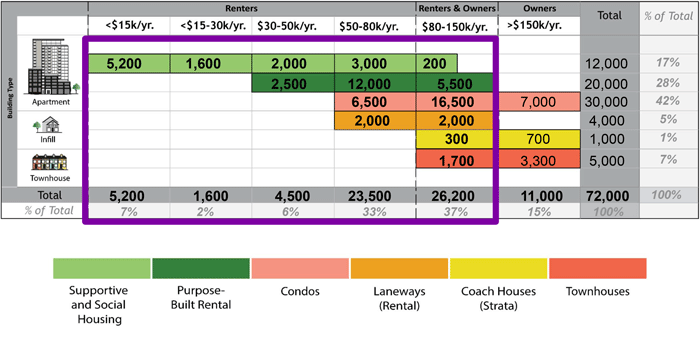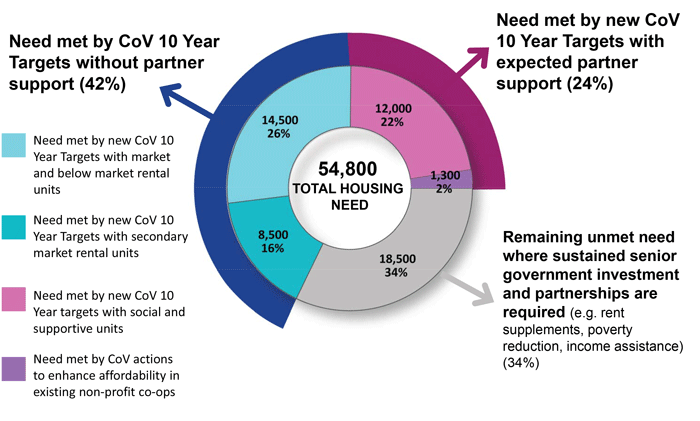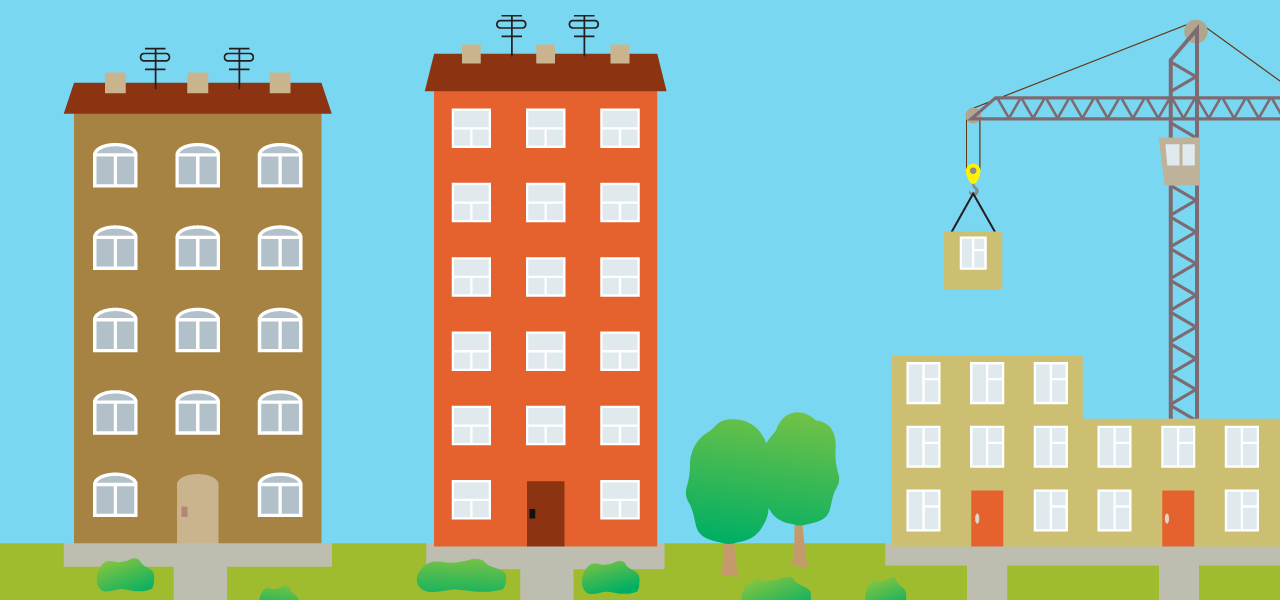Small steps on affordable housing: A look at the new federal and Vancouver plans
In November 2017 two important new efforts to address the crisis of affordable housing were delivered a day apart: a National Housing Strategy (NHS) tabled by the federal government; and the City of Vancouver’s Housing Vancouver Strategy (HVS). This piece reviews the details of these plans. Both represent forward progress, but also leave key ingredients to the February 2018 BC Budget. My earlier post reviews the BC government’s promises on housing and highlights our housing recommendations for the coming budget.
National Housing Strategy disappoints
Two years in the making, the federal government’s National Housing Strategy has been billed as a major step forward in developing a comprehensive approach to affordability. Strangely, much of the effort is delayed until 2020 (after the next federal election). The plan is aimed at helping the most vulnerable, but will do little to stem the affordability crisis facing middle-class households.
The most novel component of the new federal strategy is a Canada Housing Benefit, a rent supplement to be created as of 2020. The details are still being worked out, but the feds estimate the benefit will be an average of $2,500 per year for eligible households. This effort would complement (but hopefully not be clawed back from) BC’s two existing rent supplement programs—for low-income seniors (Shelter Aid for Elderly Families) and for low-income working families with children (Rental Assistance Program).
The NHS makes a major recommitment to housing subsidies for existing social and co-op housing in BC. This is certainly welcome news. These subsidies, which ensure dedicated housing supply for low-income households, were set to expire in the years ahead, so this move will help preserve already-existing affordable housing. Repair and upgrades to social and co-op housing are also part of the federal plan, although these funds are mostly in the form of low-interest loans rather than direct financial contributions. The NHS also puts some federal land on the table as part of new housing projects.
Where the NHS disappoints is in building new, dedicated affordable housing supply. The headline commitment of 100,000 units sounds large, but it is nation-wide, over a period of ten years, and assumes provincial contributions. When we break down the specific federal commitment of 60,000 units over ten years (to be provided through a new National Housing Co-Investment Fund) based on population, this works out to an average of about 790 new units in BC per year, about half of which would be in Metro Vancouver. That’s far less than what’s needed.
The headline commitment of 100,000 units of new, dedicated affordable housing supply sounds large, but it is nation-wide, over a period of ten years, and assumes provincial contributions. That’s far less than what’s needed.
Some additional funds target homelessness, although new money does not flow until 2019, with the modest aspiration of a 50% reduction in chronic homelessness over a decade. This is clearly inadequate in a wealthy country like Canada, and contrary to the Strategy’s promise of making housing a human right.
It should also be noted that the feds’ claim that this represents Canada’s first ever national housing strategy is bunk. The federal government was a real leader in building tens of thousands of new social and co-op housing units per year in the decades after World War II, partnering with the provinces and non-profits through the Canada Mortgage and Housing Corporation. In the post-war years, the feds also created tax incentives for a substantial build-out of affordable market rental stock.
A final note of disappointment is that the feds did not roll back the GST on new rental housing, or make any other moves that would help shift the incentives for developers away from building condos and towards rental.
City of Vancouver: Housing targets and focus on rental housing
Canada’s epicenter of housing unaffordability is arguably the city of Vancouver, and the Housing Vancouver Strategy is the most recent attempt by the municipal government to tackle affordability. The City of Vancouver is already well ahead of neighbouring municipalities such as Burnaby in using local tools and incentives to encourage investment in purpose-built rental housing, as well as protections for renters and one-for-one replacement of rental stock when new developments displace existing rental units. To boost local rental supply, the City has recently brought in an Empty Homes Tax, and new regulations on short-term rentals (like Airbnb).
Much of the media interest upon release was captured by some more radical proposals, including progressive property taxation (popularized by Jean Swanson in the recent by-election as a “mansions tax” and also advocated by the One City party in Vancouver), densifying single-family neighbourhoods, rental-only zoning, speculation taxes and banning foreign ownership. While that discourse is welcome, a careful read of the strategy document shows those proposals are more like trial balloons, hidden away from full discussion and mostly requiring provincial government approval. The main document is mainly status quo around adding more supply from the usual developer suspects.
The most innovative aspect of the HVS is a more fine-grained matrix of targets to better match new housing supply to the incomes and family composition of the local population. The figure below shows a matrix of a targeted 72,000 units to be built over the coming decade, and how that breaks down.

Housing Vancouver 10-Year Housing Targets (2018-2027)
Source: Housing Vancouver Strategy (City of Vancouver / Housing Vancouver, 2017)
Of the 72,000 new units HVS envisions over the coming decade, there would be some townhouses (5,000 units) and infill such as laneway housing (5,000 units), but mostly apartments and condos (62,000). Half of those units would be rentals, including 20,000 units of purpose-built rental housing and 12,000 units of supportive and social housing. Of 20,000 new purpose-built rental units, 4,000 of these will be “developer-owned affordable rental” units, with affordability secured over the long term and the remainder rented at market rates.
Some caution is needed around the City’s use of the term “social housing,” which is defined as rental housing in which at least 30% of the dwelling units are occupied by households with incomes below designated “housing income limits” (HILs) set out by BC Housing. For Vancouver, the HIL is $40,000 for a bachelor apartment, $45,000 for a one-bedroom and up to $77,000 for four or more bedrooms. This risks pricing out very-low-income households from supposedly affordable housing. For example, a new 100-unit building would be considered social housing even if only 30 of those units were made available to folks with incomes just below the HIL, with the remaining 70 units at market rate.
In terms of numbers of new units, Vancouver had 7,100 housing starts in 2016 and 7,500 in 2015—so the headline number of 72,000 units over a decade (an average 7,200 per year) would merely represent a continuation of current levels of build-out. Will enough of it be the “right supply” of affordable housing for those in housing need?
In the draft Strategy (released back in summer 2017), the City estimated a population of 54,800 people would be in severe housing need between 2017 and 2026 (figure below). Some 24,500 are in need today, and another 30,300 will be pushed into housing need over the coming decade without action. But the City estimated that only 42% of those in housing need can be addressed by the City alone. The remainder requires support from senior governments, in particular the social and supportive housing component. That analysis, encapsulated in the graphic below, was taken out of the final strategy document.

Source: Housing Vancouver Update Presentation to City Council (City of Vancouver / Housing Vancouver, July 2017)
Setting targets is the easy part; how those targets will be achieved is more of a mystery. Developers are expected to build most of the units, and it’s pretty clear that existing incentives for developers are to build luxury condos for wealthy buyers rather than rental units for locals. The market will never provide enough investment in housing for the homeless or other vulnerable groups because they are not profitable.
The City will need to lean heavily into those headwinds in order to meet their plan’s targets. Plans for 1,200 new modular units for homeless people, funded by the BC government, are a step in the right direction and need to be amplified. The City will also be seeking authority from the BC government to zone for rental-only, which would help cool the rampant speculation in real estate.
Finally, the recent municipal by-election highlighted the need for Vancouver to rezone and densify the vast single-family-zoned areas of the city, with almost all candidates tabling some version of this idea. Variations on this type of redevelopment have been underway for decades in several parts of the city, but this (now uncontroversial) move would expand that across the map. However, this idea seems tacked on to the HVS—it did not appear in the draft plan, and does not seem to be integrated into the supply matrix above.
Densifying the vast swath of single-family neighbourhoods is a necessary condition for the city’s growth and ability to provide affordable housing. While some commentators are concerned that this move will open Vancouver up to more condo development mania, the historical practice in existing higher-density neighbourhoods (e.g. Kitsilano or Commercial Drive) has been for smaller scale development—of duplexes and triplexes or of three-story walk-ups—much of which is not of interest to Big Developers.
However, there is no guarantee that such development will be truly affordable for those earning average incomes, much less for those in the greatest need. What is unclear is how, and how quickly, these changes will take place. A lot depends on how the rezoning is done, and whether some of the lift in property values can be captured for the public good. And zoning changes do not necessarily mean we’ll see much actual change in key neighbourhoods over the next decade.
The overarching direction of policy should be to shift away from a predominantly private market for housing to one that is regulated and managed in the interests of people who live and work in the city.
It would have been great to see the Vancouver Affordable Housing Agency play a bigger part in the HVS. Created in 2014, the Agency has 2,500 units in the pipeline (by 2021) on City-owned land. But much more could be done to keep a lid on costs if the City were to act as public sector developer and squeeze out the profit margins going to developers for new units. The overarching direction of policy should be to shift away from a predominantly private market for housing to one that is regulated and managed in the interests of people who live and work in the city.
Given the lack of new housing investment coming from the federal government, this puts the onus on the BC government to deliver on its election promise of 114,000 units (BC-wide) over ten years, which would translate into 1,400–1,900 units per year in Vancouver.
Taming demand requires support from the BC government
Ambitious plans to build more supply will come to naught if Vancouver cannot remove demand from those who seek to buy housing units as an investment rather than a place to live. A recent Statistics Canada study found that 7.6% of housing units in the City of Vancouver were owned by non-residents, and 4.8% region-wide. And close to 20% of new condos are being bought by non-residents. Whether the buyers are foreign or domestic matters less than the fact that new units are being priced beyond the budgets of all but the most affluent locals.
The City’s innovative Empty Homes Tax is a good start but it is an experiment playing out in real time. We won’t have any metrics to evaluate its progress (i.e. who’s paying the tax and who’s renting out their previously empty home) until well into 2018. Ditto for the new regulations on short-term rentals.
Nonetheless, the City deserves credit for being innovative in planning to address housing affordability, my quibbles aside. With the plan the City is pushing the boundaries of what a municipal government can do in the absence of senior government support. Indeed, there is much in the Vancouver housing policy that could be expanded across the region. Burnaby has been the regional poster child for tearing down affordable rental housing and replacing it with condo towers. It could definitely benefit low-income renters by bringing in similar rights and replacement units for those displaced by new development.
It is good news that governments have elevated housing affordability as a central public policy issue. And yet, clearly, we have much more work to do. So over to the BC government to deliver on promises to rein in speculation, provide a renters’ credit and build 114,000 units of affordable housing (ideally paid for through a new progressive property tax).
Topics: Features, Housing & homelessness






